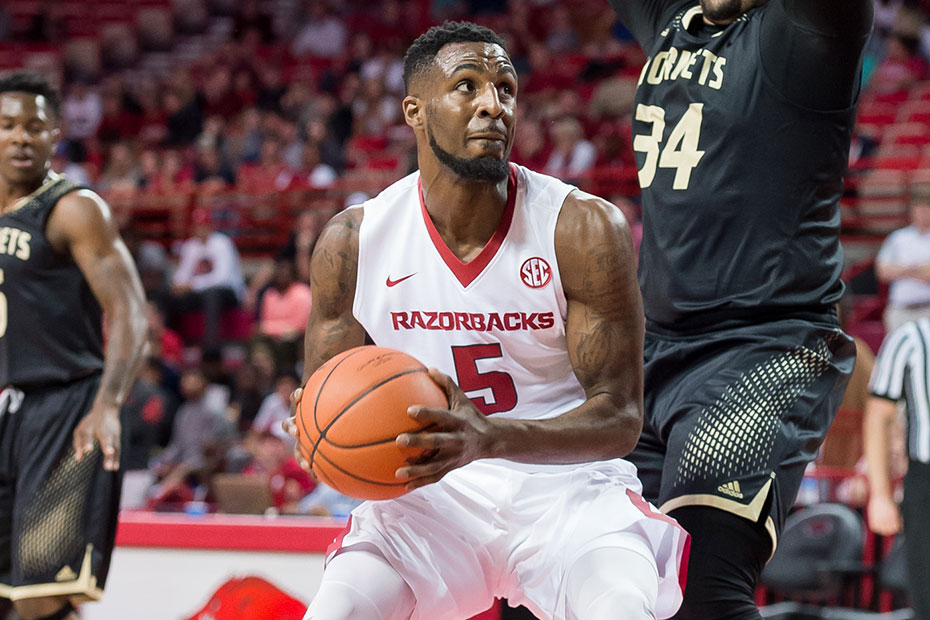
Arkansas junior forward Arlando Cook / Photo : Walt Beazley, ArkansasRazorbacks.com
Next to a team’s won-loss record, field-goal percentage is probably the most important statistic in college basketball.
All things considered, if a team is more efficient at scoring than its opponent, then it has a lot better chance of winning the basketball game.
So far this season, Mike Anderson’s Arkansas Razorbacks have been pretty good in those categories.
After nudging Texas, 77-74, last Saturday, the Razorbacks are 9-1 on the season. A year ago, the Hogs stood 5-5 at this juncture.
As far as shooting goes, the Hogs thus far have been a good-shooting basketball team, averaging 47.0 percent shooting from the field (295 of 628). The Hogs have also been OK on defense, holding opponents 41.8 percent shooting (246 of 589).
A 5 percent difference is good. It’s a winning percentage no matter how you look at it. Your better college basketball teams — ones that have a shot at going deep in the tournament — will average closer to 50 percent from the field, while holding opponents closer to 39 percent from the field or even less.
Those are the type of numbers Nolan Richardson’s best teams in the late 80s through the mid 90s danced with. Those great teams also got up a lot more shots than their opponents. More shots with a higher shooting percentage equals victories.
Right now Anderson’s squad is taking 3.9 more shots a game than their opponents and averaging 4.9 more makes. Those are good numbers, winning numbers, but not great numbers.
A place where a team can gain an advantage in scoring is, of course, three-point shooting percentage. Again the Hogs’ three-point shooting percentages are OK, but certainly not exceptional. The Razorbacks are shooting 35.9 percent from the field (60 of 167), which is solid.
However, the numbers say the Hogs could do a better job of defending the three. Right now, their opponents are cashing in from the three-point line at a 35.6 percent clip (78 of 212). So opponents are taking 4.5 more threes than the Razorbacks per game and making 1.8 more threes for a 5.4-ppg. advantage.
That’s not horrible, but it is a number the Razorbacks should work at improving on by clamping down a bit more on opponents around the three-point line. The Hogs are going to leave teams open looks in an attempt to hurry opponents up, but they might be a bit more selective in whom they allow those looks to go to.
Where the Razorbacks are doing well is at the free-throw line. The Razorbacks have made 192 of 243 free throws this season for an average of 79.0 percent. Their opponents have made 152 of 226 free throws for a percentage of 67.3 percent from the field. Arkansas is averaging 4 more points a game from the free-throw line than their opponents on 1.7 more trips to the line. Considering how aggressively the Razorbacks use their hands on defense, those are pretty good numbers.
Surprisingly, the Hogs turnover margin per game is just a positive 1.8 with the Hogs averaging 12.8 turnovers a game to their opponents 14.6. For the speed at which the Razorbacks play 12.8 turnovers isn’t terrible, although I’m sure Anderson would rather see it under 11. However, 14.8 forced turnovers per game is less than what one might expect from a squad that extends its pressure as much as the Razorbacks do.
All in all, Arkansas averages 84.2 ppg. to their opponents 72.2 ppg., for a 12 ppg. differential. Again that’s not bad, but one would have to expect those numbers to contract in SEC play. They always seem to, anyway.
The Razorbacks are averaging 5.7 more rebounds a game than their opponents and 1.6 more offensive boards than their opponents.
As it stands, Razorbacks fans ought to expect a lot of close games in SEC play. Arkansas’ SEC schedule begins on Dec. 29 when Florida visits Bud Walton Arena for an 8 p.m. contest. The good thing is the Razorbacks have the opportunity to improve as a team as the newcomers continue to mix with the Hogs’ returning players.
The Razorbacks don’t have any superstars on the squad, but they are a team filled with solid players. It appears the Razorbacks will be able to play nine to 11 players routinely without experiencing a drop off when Anderson substitutes.
The Razorbacks aren’t particularly long or tall basketball team, but they are physical and strong, especially at the guard spot.
Daryl Macon, Jalen Barford, Manny Watkins, and Anton Beard are strong with the ball and go to the basket with skill and power. Senior Dusty Hannahs is tough, clever and skillful. He’s not just the spot-up shooter some think him to be.
Texas outshot Arkansas last Saturday, hitting 40.3 percent from the field to the Hogs’ 35.5 percent, but the Hogs made the most of their trips to the free-throw line, connecting on 29 of 31 free throws, with Macon doing the bulk of the damage on a 14-for-14 day from the charity stripe. That type of opportunistic play is something the Razorbacks will need in SEC play to float in the upper half of the league.
While Moses Kingsley’s offensive game seems to have regressed a bit from a year ago, likely from the different make-up of the team, the senior brings his hardhat and lunch pail every night on defense. He averages 3.1 blocks, 8.4 rebounds and 10.7 ppg. in just under 28 minutes of playing time. He swatted five shots against the Longhorns, grabbed 10 rebounds and scored 7 points.
With two games to play before Christmas and the SEC opener against Florida, it would be nice to see if the Razorbacks can get Kingsley on track offensively in Tuesday’s game against North Dakota State at Walton Arena and Thursday’s game against Sam Houston State at Verizon Arena in North Little Rock.
The Razorbacks really do need him to play with confidence on both ends of the floor if they want to reach their full potential this season.

